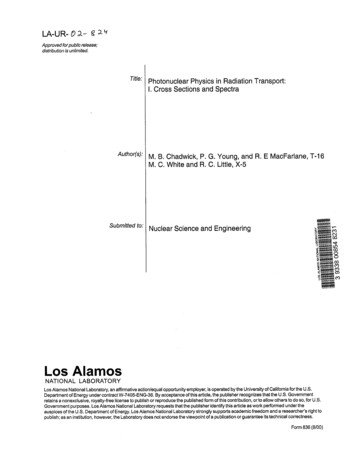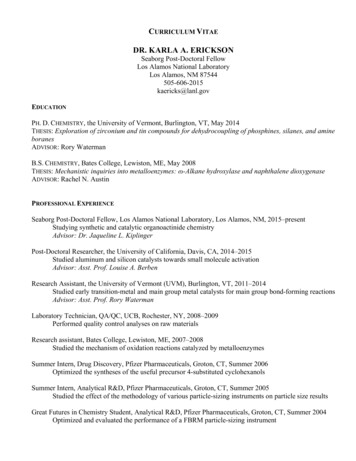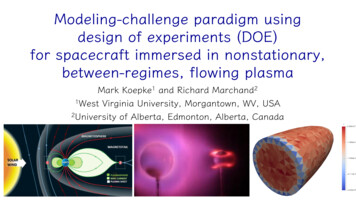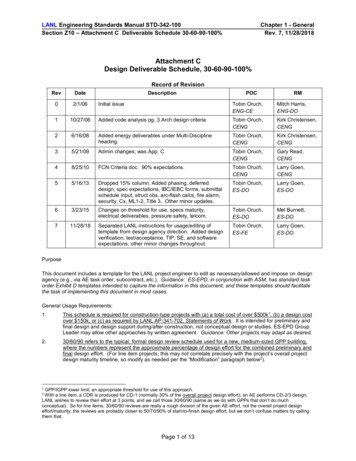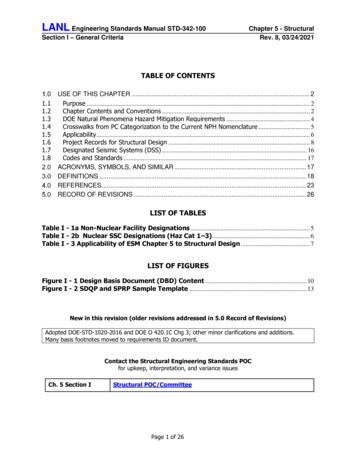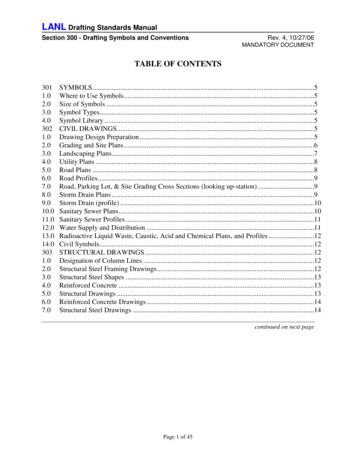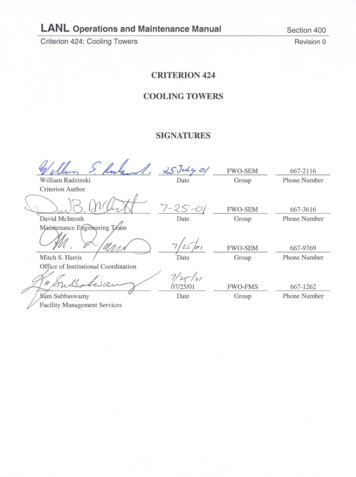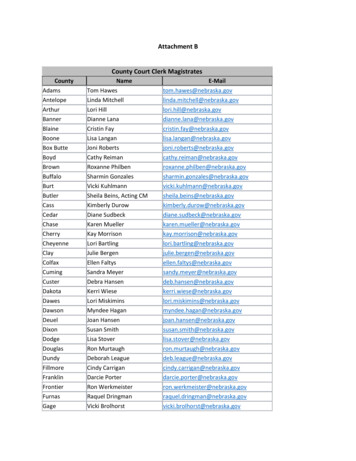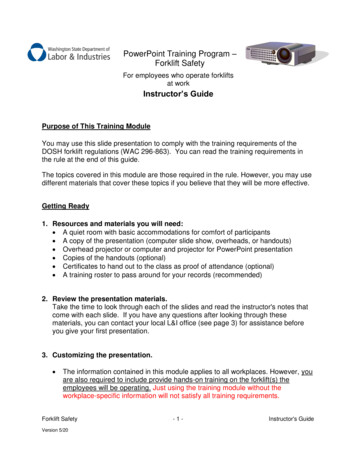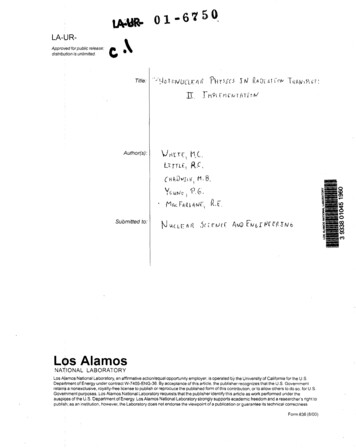
Transcription
-6LA-URApproved forpublic releesedistnbubonIS unkmrtedTitle:A uthor(s):Submitted io.LQSAlamosNAT I 0 NA L LAB0 R A T 0 R YLos Alamos National Laboratory, an affirmative action/equal opportunity employer, is operated by the University of California for the U SDepaAmentof Energy under contract W-7405-ENG-36 By acceptance of this article. the publisher recognizes that the U S Governmentretain6 a nonexclusive, royalty-free license to publish or reproduce the published form of this contribution, or to allow others to do so for U SGovernment purposes. Los Alamos National Laboratory requests that the publisher identify this article as work performed under theauspiqes of the U S Department of Energy Los Alamos National Laboratorystrongly supports academic freedom and a researcher's right lopublish, as an institution, however, the Laboratorydoes not endorse the viewpoint of a publication or guarantee its technical correctnessForm 836 (8100)
Photonuclear Physics in Radiation Transport:11. ImplementationM.C. White and R.C.LittleApplied Physics Division, University of CaliforniaLos Alamos National Laboratory, Los Alamos, NM 87545M.B. Chadwick, P.G.Young, and R.E.MacFarlaneTheoretical Division, University of CaliforniaLos Alamos National Laboratory, LQSAlamos, NM 87545AbstractThis is the secmd of two consecutive papers presented. In the Fmt paper, we describedmodel calculations and nuclear data evaluations of photonuclear reactions on isotopes ofC, 0, Al, Si, Ca, Fe, Cu, ‘I’a, W, and Pb, ,for incident photon energies up to 150 MeV.This paper describes the steps taken to process these files into transport libraries and toupdate the Monte Carlo N-Particle (MCNPTM) and MCNPXTM (extended) radiationtransport codes to use tabular photonuclear reaction data. The evaluated photonucleardata files are created in the standard Evaluated Nuclear Data File (EWDF) format. Thesefiles must be processed by the NJOY data processing system into A Compact ENDF(ACE) files suitable for radiation transport calculations. MCNP and MCNPX have beenmodified to use this new data in a self-consistent and fully integrated manner.1 of 24
Verification problems were used at each step along the path to check the integrity of themethodology. The resulting methodology and tools provide a comprehensive system forusing photonuclear data in radiation transport calculations. Also described are initialvalidation simulations used to benchmark several of the photonuclear transport tables.I. IntroductionPhotonuclear physics, until recently, has remained a strangely neglected subject ofstudy in radiation transport computations. Libraries of evaluated nuclear dataJiles(ENDF), such as the U.S. ENDFB cross-section libraries [ 11, have not previouslyincluded evaluated photonuclear cross-section data although the capability to do so hasbeen in place. Neither have the standard radiation transport codes included acomprehensive capability to utilize such tabulated data. While it is true that photonuclearreactions are typically negligible in transport simulations involving more dominantnuclear reactions (e.g. fission, fusion, or high-energy ion transport problems),photonuclear reactions are the primary source of nuclear particles in transport simulationsof electrodphoton showers. For this class of simulation problem, a key process has beenmissing.We present here two consecutive papers describing work at Los Alamos NationalLaboratory to develop a photonuclear physics capability in our nuclear modeling, dataprocessing and radiation transport codes. The first paper [2] describes the evaluationmethods, including nuclear model calculations, used to produce evaluated photonuclear2 of 24
cross-section data in the ENDF format. Results were presented for photons with incidentenergies up to 150 MeV on twelve isotopes: 12C, l60,27Al,**Si,40Ca,"Fe, 63Cu,"'Ta,* 84W,and 206*207 208Pb.These isotopes are representative of materials found in acceleratorcomponents, collimators and beam-shaping devices, beam-stops, bremsstrahlungconversion targets, shielding, as well as elements abundant in human tissue, and comprisea useful library for many simulations. This second paper describes the processing pathfrom ENDF library to ACE transport library (the standard data files used by MCNP andMCNPX)); the extensions to the MCNP [3] and MCNPX [4] codes to use the data; and aset of validation simulations benchmarking the new data. (Discussions within this paperusiog the acronym MCNP(X) indicate applicability to both MCNP and MCNPX.) Partsof this work have been published in a conference proceedings [5] and as part of one ofthe authors thesis [ 6 ] .There are two principal reasons why photonuclear capabilities have not previouslybeen included in radiation transport codes through the use of evaluated data libraries: (1)experimental photonuclear data from different laboratories (e.g. data from measurementprograms at Livermore, Saclay and Illinois) often show discrepancies that must beresolved in the evaluation process; and (2) there are few measurements of the energy- andangle-dependent spectra of secondary particles emitted in photonuclear reactions. Mostof the existing spectral measurements are for bremsstrahlung photon sources and are onlyuseful for integral testing. Only measurements from monoenergetic sources giveemission spectra directly useful for cross-section evaluations. Because radiationtransport codes need double-differential cross-section data, the widely available3 of 24
photonuclear data compilations, such as those of Dietrich and Berman [7] and Varlamovet al. [SI,are not immediately useful in a transport context. This is where the evaluationmethodology described in the previous paper fills in the holes in measurements by usingnuclear model calculations to calculate missing cross sections and provide emissionspectra. These cross sections and spectra are calculated in a self-consistent manner andthen validated through comparisons with measured values. The final completeevaluations provide the data necessary to perform radiation transport simulations.A number of researchers from laboratories in Japan (JAERI,Tokyo), South Korea(KAERI, Taejon), Russia (IPPE, Obninsk and Moscow State University, Moscow), China(CIAE, Beijing), Brazil (University of Sao Paulo, Sao Paulo) and the United States(LANL and BNL) have recently worked on the development of evaluated photonucleardata for transport applications. The efforts described by our two papers have been madein coordination with this International Atomic Energy Agency (IAEA) CoordinatedResearch Project (CRP) entitled “Compilation and Evaluation of Photonuclear Data forApplications” [9].The final report [lo] from this project documents over 160photonuclear evaluations. The isotopes chosen for inclusion represent those materialsimportant in neutron radiation shielding design and radiation transport analyses;calculations of absorbed dose in the human body; physics and technology of fission andfusion reactors; activation analysis; safeguards and inspection technologies; nuclearwaste transmutation; and astrophysical nucleosynthesis.4 of 24
While this pair of papers is the first to present photonuclear reaction analysisusing evaluated data via the ENDF format, it is important to note that previous workshave included photonuclear reactions in transport simulations using other methodology.The studies mentioned here are by no means a comprehensive review but are intended toprovide a feel for what has been done in past. Two approaches have dominated pastefforts. The fust approach is the use of intranuclear cascade codes to computephotonuclear reactions “on-the-fly” during a simulation. The works of Alsmiller et al.[ll]; Gabriel [12]; Fasso, Ferrari, and Sala [13,14]; and, Mokhov et al. [15] areparticularly noteworthy. The primary advantage of this approach is the ability tocompute reactions on almost any target isotope over a wide range of incident photonenergies. The primary disadvantage is that the computational accuracy, comparingcomputed to measured cross sections, can vary greatly due to the generalized nature ofthe model, especially in isotopic or energy regimes outside the primary focus area of themodel. It is worth observing that Fasso [ 143 mitigates this problem by the use ofexperimental measurements where available.The second approach has been various ad-hoc methodologies to use tabular data.One of the most common has been to use an electrodphoton transport code to computethe photon flux within a volume of interest. This flux is folded with a photoneutronproduction cross section to calculate a neutron source term. This source term, with asuitable emission distribution, is then used as a source in a neutron transport code.Notable examples of this approach include the work of Chadwick et al. [ 161; Swanson[17,18], McCall et al. [19]; Gallmeier [20]; and, Vertes and Ridikus [21]. The last two5 of 24
examples are particularly noteworthy. Gallmeier modified MCNP and Vertes andRidikus modified both MCNP and MCNPX to use tabulated data to compute neutronproduction and analytic expressions to compute emission spectra to perform coupledelectrodphotodneutron transport. The work presented in this paper extends thisapproach to its logical conclusion. We present herein a formalized methodology for theproduction, processing and usage of tabular data in transport simulations. The primaryadvantage of this approach is that each tabular data set is produced to agree as closely aspossible with measured data. The disadvantage is that a tabular data set must be createdfor every material of interest. However, the IAEA library will extend the 12 isotopespresented in the current work into a set that should be sufficient for almost anyapplication. This larger library is currently undergoing review and testing.I'This paper is organized as follows. Section I1 describes the processing andstorage of the photonuclear data library including some discussion of the philosophy ofdata storage as driven by transport simulation needs. Several developments werenecessary to the NJOY data processing code in order to process the photonuclear ENDFfiles into transport tables. Section I11 describes the updates and extensions to the MCNPand MCNPX codes that were necessary to use the data in a transport simulation. Thisincludes discussion of issues related to code set-up and storage, user interface, samplingalgorithms, biasing for variance reduction, and reporting of results. Section IV describesthe results of several benchmark problems used to validate several of the data sets. Ourconclusions are given in Section V.6 of 24
11. Radiation Transport DataRadiation transport codes need complete data. Complete implies the inclusion ofinteraction data for all materials in the geometry modeled by the simulation with reactionrates and emission spectra coupling all physical channels between particle species overthe energy range of interest. Data are rarely, if ever, complete. In practice, codes usedata that are “good enough.” It is noteworthy that the evaluated photonuclear data setspresented in the first paper are complete and include production cross sections andemission spectra for all possible reaction channels, not just neutrons. These new dataenable more accurate coupling between particles and represent a significant improvementin the state-of-the-art for radiation transport simulations.One of the most powerful, though often overlooked, features of the MCNP(X)codes is the use of a standardized methodology for storing and utilizing interaction data.This provides the ability to use data from a wide variety of sources. For example,neutron data is created in the ENDF format by several organizations around the world.Data from any of these libraries can be processed using the NJOY data processing systemand the resultant ACE transport tables can be used in MCNP(X). This allows the expertuser to create data sets using the best available information for their purpose. Theprimary goal of this work was to establish a standardized methodology for storing andutilizing tabular photonuclear data.7 of 24
The issue of storage was a key question to be decided in the early stages of thisproject. Photon interaction data already exist in the form of photoatomic interaction data.Photoatomic interactions are mainly characterized by elemental features, specifically thenumber and distribution of electrons around the atom and the charge of the nucleus,Photonuclear interactions are characterized by isotopic features, i.e. the number ofneutrons and protons in the nucleus. Additionally, evaluated photonuclear data areupdated one at a time, as needed for a particular isotope. Updates of photoatomic,electron and atomic relaxation data are usually done all at once in order to provide a selfconsistent set of atomic libraries. With these and other factors in mind, it was decidedthat the current photoatomic format and data should be unchanged and that photonucleardata should be stored separately.After deciding that photonuclear data should be stored separately, it wasnecessary to create a new table format for the data. The photonuclear process involves anincident photon exciting a nucleus with the subsequent emission of nuclear particles. It isexpected that photonuclear reactions produce secondary particles with emission spectrasimilar to neutron-induced nuclear reactions. Therefore, the same data formats andsampling laws that are used to describe secondary emission for incident neutrons may beused for incident photons. The neutron class ‘n’ ACE table and the “ace” routines withinMCNP(X) have a distinguished history of simulating particle emission from neutroncollisions. The new class ‘u’ ACE table [22] draws on this history for storing andsampling photonuclear interactions. It stores the standard data necessary for transportand reaction calculations; i.e. the total cross section, the secondary particle production8 of 24
cross sections, the individual channel cross sections with related secondary yields, thesecondary particle emission spectra and reaction multipliers of interest, e.g. heatingvalues.The NJOY data processing system [23] has been the standard code used toprocess ENDF formatted data into transport data for many transport codes. The ENDFformat is designed to contain interaction information in a compact, precise manner. Thisis rarely the form needed for efficient transport algorithms. NJOY is capable ofprocessing ENDF format data into a wide variety of other formats including the ACEformat used by MCNP(X). Beginning with NJOY99 [24], the NJOY system has includedupdates to process photonuclear data in ENDF format into ACE class ‘u’tables.The twelve LANL photonuclear evaluations have been processed usingNJOY99.5 to create the LA15OU class ‘u’ACE library [25]. These tables are ready foruse in the photonuclear enabled versions of MCNP(X). The modifications in MCNP(X)necessary to sample photon collisions, including both photoatomic and photonuclearevents, are the subject of the next section.111. ImplementationExtensive modifications were necessary in order to load, sample and reportinformation about photonuclear collisions in MCNP(X). The user interface required new9 of 24
constructs to allow specification of two photon interaction tables for each materialcomponent. The sampling routine required revisions to use the total photon cross section,photoatomic plus photonuclear, for calculating the distance-to-collision, The collisionroutine required additional interaction routines to include production of secondaryparticles from photonuclear collisions. The new routines also required integration withthe existing variance reduction schemes, standard tallies and user output summaryinformation. These modifications have been completed and are available beginning inMCNP release 4C2 and MCNPX beta release 2.2.3. Each of these modifications isdiscussed in more detail below. This discussion presumes the reader is familiar with thestandard MCNP(X) features.The decision to store photonuclear and photoatomic data in separate tablesrequired the extension of the material specification card in the MCNP(X) input deck.e.g. 24u, as part of theThe material card now recognizes ZAIDs with photonuclear IDS,component specification. Also, the material library ID for photonuclear tables may be setusing the new pnlib ID option. These two features extend the standard options availablefor neutron, electron and photoatomic tables. As before, ACE tables are selected for amaterial by finding an exact match to a given component ZAID; a match to thecomponent ZA and library ID; the first available match to the component ZA and anappropriate table type; or, setting a fatal error state; in that order respectively.Electrodphoton simulatjons have a complete set of data for elements up to Z of94. Neutron simulations have a fairly complete set of data for most isotopes and/or10 of 24
elements in this range. However, since there is not a neutron data set for everyisotope/element, neutron simulations typically use “good enough” approximations ofmaterials. Therefore, material specification for problems involving neutron transport hasbeen dominated by the selection of the neutron tables with the assumption that thecorresponding photon and electron tables will be available. The addition of a sparse setof photonuclear tables complicates the material specification problem.The issue is how to specify a material to use the best set of neutron andphotonuclear data when the data sets may not include tables for all the sameisotopes/elements. For example, natural tungsten is composed of five isotopes. Thestandard neutron libraries have tables for only four of the five. Typically, a MCNP(X)material specification calls for the four existing tables in their natural proportions andsplits the atom fraction of the fifth isotope among them. The correct elementalphotoatomic and electron table is attached to each for the four isotopic constituents.However, the current set of photonuclear tables have data for only one isotope oftungsten. It would be counter-productive to force the material specification to use onlyone isotope of tungsten because that was the only photonuclear table available. Thisproblem will continue to exist as long as there is a mismatch between the neutron andphotonuclear tables available.The photonuclear isotope override card, labeled by MPN in an input deck,provides a solution whereby photonuclear material components may use a different 24than that in use for electron, photoatomic and neutron tables. After the material card has11 of 24
defined each component, typically based on the best set of neutron tables, a MPN cardcan be used to specify, possibly different, the components used to select photonucleartables. The combination of a M and MPN card will allow users to select the bestavailable neutron and photonuclear tables independently. Returning to the exampleabove, the material card selects the four neutron tables as the best description of naturaltungsten. The photonuclear isotope override card allows the user to specify each materialcomponent to use the one photonuclear table.The photonuclear isotope override card provides a method for another interestingcapability. At present, only 12 photonuclear tables are available. The MPN card doesnot restrict the user’s choice of a substitute table. It is therefore possible to makesubstitutions between elements, e.g. substitute 207Pbfor 2wBi. Any substitution should bechosen with care but this can be a useful technique to estimate the effect of a materialcomponent for which a table does not currently exist. Lastly, a zero value turns offphotonuclear interactions in the material component. Full documentation of the changesin the material interface is available [26] as well as a primer for using this new capability 71.Given the complexity of choosing appropriate tables, the interface describedabove is considered only an interim measure. As new capabilities for sampling tabulardata appear in MCNP(X), the task of material specification will become even morecomplicated. Future work has been proposed to create a material module where the userwould specify the components independently for each type of data table as well as the12 of 24
true material composition. One could eventually envision specifying a molecular orelemental photoatomic, electron and thermal-neutron data sets and isotopic neutron,photonuclear and proton data sets.In the past, MCNP(X) has sampled the distance-to-collision for photoninteractions based solely on the total photoatomic cross section as that was all that wasavailable. Below the photonuclear threshold, this is correct and above the threshold thisis typically a negligible error. Only in the vicinity of the giant dipole resonance is thephotonuclear cross section more than one percent of the total photon interaction crosssection. Even in the resonance, it is only a few percent of the total. For this reason, usingthe total photoatomic interaction cross section to sample the distance-to-collision has notbeen unreasonable. Now, when photonuclear physics is enabled, the distance-to-collisionis calculated from the more accurate total photon interaction cross section.Once a photon has reached a collision site, both photoatomic and photonuclearsecondary particles may be sampled. How this occurs is tightly coupled to the variancereduction scheme in use. First, consider the case of pure analog Monte Carlo. In thiscase, the initial logical decision is to choose either a photonuclear or photoatomicinteraction. If the even is determined to be a photoatomic collision, it is sampled usingthe photoatomic interactions as previously established. Otherwise, the event isdetermined to be a photonuclear interaction and the code then loops through eachpossible secondary particle type and samples an integer number of particles to be emitted,possibly zero, based on the ratio of the particle production cross section to the total13 of 24
photonuclear cross section. The emission energy and angle for each secondary particle issampled independently from the available reactions. This is the standard samplingprocedure used by MCNP(X) for neutron collisions and preserves the correct distributionstatistically though not at a specific collision.Because of its small cross section, a photonuclear interaction is a rare event.Given that these interactions are the primary source of nuclear particles that may be thefocus of a given simulation, it is useful to have biasing techniques to sample them moreoften. Two biasing techniques are recommended for use in photonuclear simulations.These are photon collision splitting and weight windows.Photon collision splitting is a biasing technique whereby the photon is split in twoat each collision site. One photon undergoes a photoatomic interaction; the otherundergoes a photonuclear interaction. Each has its weight updated to match theprobability of the respective interaction type. This is a new feature for use withphotonuclear collisions. It relies on the same concept underlying both implicit captureand forced collisions.Weight windows are a particle population control method. Because of the lowprobability of producing secondary particles from photonuclear interactions, any biasingtechnique that produces more of them can also produce intensely different particleweights. In order to limit such effects, weight windows force particles into a weightrange by splitting or rouletting particles outside of that range. The photonuclear collision14 of 24
routine will always split or roulette the number of secondary particles such that they arein the appropriate weight range as specified by the current weight window.While other biasing methods have also been made to work, the two outlinedabove are the only ones recommended. When weight windows are not used, thephotonuclear collision routine will produce secondary particles and then subject them toroulette, i.e. termination, based on the current weight cutoff. Remember that the weightcutoff is modified by the ratio of the neutron importance in the current cell to the neutronimportance in the source cell. This is an obscure feature inherited from the codes neutrontransport origins and create unintended consequences when using geometry importance’swith weight cutoffs.Because the secondary particle production from photonuclear interactions isperformed inline, it is automatically accounted for in the requested tallies. No additionalinformation or action is required on the part of the user, nor within the code. All of thestandard tallies, including point detectors, are available. Note that the routine to calculatethe probability of a secondary neutron or photon scattering in a certain direction (used bythe point detectars and dxtran spheres) has been updated to allow the photonuclearreaction types used within the LA150 library. Use of other data sets inay requireadditional modifications. The code will give a bad trouble error and exit upon seeing anext-event reaction type that has not been fully implemented and verified. This does notaffect transport, only next event estimators.15 of 24
Additional information has been added to the print tables to reflect photonuclearinteractions. This includes global and cell-by-cell statistics on photon loss due tophotonuclear absorption; global and cell-by-cell statistics on photonuclear production ofsecondary particles; and, cell-by-cell, nuclide-by-nuclide statistics on photonuclearinteractions. This new information supplements existing tables and should be familiar tousers.The capability to sample tabular photonuclear physics has been successfullyintegrated into MCNP and MCNPX. These codes are being distributed through thenormal distribution centers. While fully integrated into the transport sections of the code,some additional work is still necessary. The “ptrac” routines need to be updated toinclude photonuclear events, the plotting routines need to be updated to plot thephotonuclear cross sections and the tally multiplier card (FM) needs to be able to accessphotonuclear reaction data. These features will be addressed in future code releases.IV. ValidationThis section reviews the initial validation benchmarks performed as part of theprocess of implementing the photonuclear physics capability. Almost every previouseffort to estimate photoneutron production has been benchmarked to experimental datapublished by Barber and George [28]. The Barber and George paper is exceptionallywell written, documenting the key aspects of their experiment and results and reporting16 of 24
there data in a manner well suited for comparison with calculations. For this reason itwas chosen as the starting point for validating the current photonuclear physicsimplementation.The Barber and George experiments measured total neutron yields of severalmaterials bombarded with electrons of various incident energies. Of interest to thecurrent work, measurements were made on aluminum, carbon, copper, lead and tantalumtargets. Measurements were reported as the number of neutrons emitted fiom the sampleper electron incident. The reported values accounted for detector efficiencies andbackground. This inakes direct comparison of measured and calculated values possibleas the number of neutrons escaping from the surface per electron incident on the targetcan be tallied using standard features of the MCNP(X) codes.The experimental measurements were made using the Stanford Mark JIAccelerator during the late 1950’s. They followed a series of experiments to characterizethe electron beam. The incident electron beam was very well understood. The target waslocated in a Lucite vacuum chamber surrounded by paraffin moderator. Enriched BF3proportional counters in the paraffin were used for neutron detection and the neutrondetection efficiency was measured. Barber and George estimate their absolute accuracyas /-15%. The targets were 4.5 inches square and of varying thickness. Because of theway in which the measurements were analyzed and reported, the only portion of theexperiment necessary to model is the electron beam incident on the target. The numberof neutrons escaping the target per incident electron is tallied and compared to the17 of 24
experimental value. Simulations of these measurements were run using MCNP version4C2. Each simulation was run until the Monte Carlo statistical error was negligible.Figures 1 through 13 show comparisons of experimental to calculated values. Thenumeric data are available in Appendix A.The overall agreement between the calculated and measured values is good. Thiswork, as represented by both papers, has been a difficult endeavor due to the sparseavailability of measurements available for use in creating and validating the data sets andthere use. Most of the validation calculatjons are within 25% of the experimental results.The results outside this range involve either thinner targets or points closer to the energythresholds both conditions that are inherently difficult to calculate. It should be statedthat the calculations generally underestimate the experimental values. However, thisdisagreement may be due to other causes. It is unknown if there were possible systematicerrors in the experimental measurements. Because of the integral nature of theexperiment and the corresponding simulation, these results are sensitive to the electrontransport process, to bremsstrahlung production and to the photon transport process.Further, electro-disintegration effects that may be important in thin targets are ignored.The results for aluminum, carbon, lead and tantalum were obtained fromcalculations with data tables for each of the major isotopes of the element. As seen inFigure 1, calculations for aluminum are in reasonable, within 25%, agreement with theexperimental values. Figure 2 sh
incident photon exciting a nucleus with the subsequent emission of nuclear particles. It is expected that photonuclear reactions produce secondary particles with emission spectra similar . to . neutron-induced nuclear reactions. Therefore, the same data formats and sampling laws that are used to describe secondary emission for incident neutrons .
